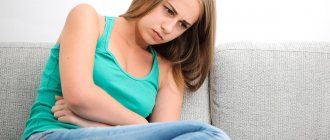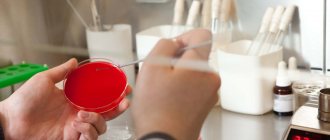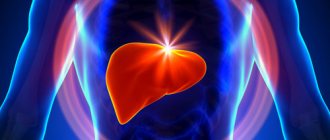How is it formed and what does it consist of?
From the stomach, food masses enter the duodenum, where they are mixed with bile produced by the liver and digestive enzymes of the pancreas. During the digestion of proteins, fats and carbohydrates, a suspension is formed that moves through the small intestine. The small intestine absorbs nutrients into the blood, and the remaining liquid waste enters the large intestine. In the large intestine, the remaining water is absorbed and feces are formed, which are excreted into the environment through the distal part of the digestive tract - the rectum.
Normal stool consists of water, remains of animal food, undigested plant fibers, bacteria (up to 1/3 of the dry weight of stool), bile, and dead cells of the mucous membrane lining the digestive tract. The composition, consistency, quantity and color of feces depend on many factors and are one of the indicators of the health of the body in general and the gastrointestinal tract in particular.
Stool after beets in children and adults - what is the difference?
The presence of a well-formed digestive system in adults promotes adequate digestion of beets and its removal from the body. It should be understood that the younger the child, the more difficult it is for the intestines to cope with excess amounts of red vegetables.
The presence of burgundy stool in a child with remnants of undigested beets is not a cause for concern. However, a combination of such changes in stool and a deterioration in the child’s general condition may indicate diseases of the gastrointestinal tract. You should definitely contact your pediatrician.
Normal stool color
Stools are usually brown in color, and significant changes in color may be a cause for health concern. The color of stool is determined by the presence of bilirubin (a breakdown product of hemoglobin) and other bile pigments. Changes in the amount of bilirubin in the bile can change the color of the stool from light yellow to dark brown.
In most cases, changes in the color of stool are associated with dietary habits and are not a symptom of any health abnormalities. However, in some cases, for example, if the color of the stool has changed radically, and these changes persist for a long time, this can be an important diagnostic sign of dangerous diseases and serious life-threatening conditions.
Treatment of pancreatic diarrhea
Pancreatitis is one of those diseases that may not manifest itself for a long time, thereby complicating the process of subsequent treatment. However, there are a number of signs by which an attentive person can detect certain changes in his body and respond to them in time. One of these signs is stool.
Feces with pancreatitis change quite a lot, so it is important to pay attention to this and consult a doctor, even if there is nothing else to worry about. If you doubt whether the appearance of feces is normal, you can always find a photo on the Internet and compare. If the pancreas malfunctions, the stool becomes liquefied, does not come out immediately, but in small parts, and contains undigested food particles, which indicates a lack of enzymes.
There are quite a lot of options for the shape and consistency of stool with pancreatitis, but we can highlight those that are most common:
- Thin and long, resembling a ribbon. This option indicates problems with the sigmoid colon and tumor processes.
- The so-called "sheep's balls", indicating the presence of constipation and ulcers.
- Unshaped chair.
Digestive dysfunction is the main symptom of diseases associated with inflammation of the pancreas.
There are a number of features of stool with pancreatitis:
- During antibacterial therapy, stool becomes yellow and resembles plasticine in consistency.
- With pancreatitis, the color of stool changes to gray or very light, and undigested fats add shine to it;
- Feces have a foul odor and become very viscous (it is difficult to wash off clothes and is difficult to wash off surfaces).
Lack of medical care or untimely initiation of treatment can lead to very unpleasant consequences, the basis of which is dehydration:
- weight loss;
- inflammation of the mucous membranes;
- anemia;
- acute lack of vitamins and minerals;
- insomnia;
- apathy against the background of permanent neurosis.
One of the most alarming symptoms of pancreatitis is black diarrhea. Any doctor, hearing such a complaint, will be seriously concerned about the patient’s condition, since this indirectly indicates internal bleeding. It is blood that can color stool black.
Diarrhea, no matter what disease it is caused by, requires an immediate response, because it instantly leads to dehydration of the body and causes serious complications. For pancreatitis, a comprehensive approach is taken to solving this problem:
- prescribe medications;
- recommend strict adherence to a therapeutic diet;
- The use of traditional methods is allowed (with prior consultation with a specialist).
The treatment strategy for diarrhea always depends on the form of pancreatitis and the presence of concomitant diseases. Traditionally there are 2 ways:
- Oral. It consists of prescribing enzyme-containing drugs that facilitate the functioning of the pancreas (Creon, Pancreatin, Bifidumbacterin, etc.).
- Intravenous. Used in acute periods when immediate response is required. It is carried out in a hospital. Solutions of electrolyte salts are prescribed (Disol, Trisol, etc.)
Folk remedies
If the situation is not critical, and the doctor has approved the proposed method of treatment, you can try folk remedies. Traditionally, they consist of consuming decoctions of medicinal herbs.
A decoction of corn silks and other medicinal plants:
- take equal parts of corn silk, chamomile and calendula inflorescences;
- pour boiling water at the rate of 1 tbsp. herbal mixture per 1 glass of water;
- leave for 1 hour;
- consume half an hour before meals.
- take mint, elecampane and string in equal parts;
- pour boiling water at the rate of 3 tbsp. spoons of prepared herbal mixture per 0.5 liters of water;
- Seal tightly and leave for at least 1 hour.
Abnormal bowel movements during pancreatitis are common, but it is important to respond to it in time and consult a specialist. With timely treatment, you can get rid of this unpleasant symptom. In diseases associated with digestive dysfunction, one of the most important conditions for positive dynamics is the patient’s attentive attitude to changes in his body.
If you have diarrhea, it is important to follow a diet and avoid fatty, fried, smoked, and grilled foods. Fatty meat should be replaced with dietary meat and consumed only in pureed, chopped form, and low-fat sour dairy products should also be eaten. It is worth giving up confectionery, baked goods, honey, jam, radishes, garlic, onions, fresh bread, chips, hot crackers, sushi, and fast food.
When should a change in color alert you?
A cause for concern should be those cases when a change in stool color is accompanied by other symptoms:
- Green and foul-smelling stools are accompanied by diarrhea, abdominal pain, high fever, nausea and vomiting - possible symptoms of some infectious diseases, such as salmonellosis.
- Discolored feces are accompanied by pain in the abdomen, back, yellowness of the sclera and skin, darkening of the urine - signs of problems with the liver and biliary tract.
- Stool staining black is accompanied by abdominal pain, weakness, pale skin, increased heart rate, cold sweat - symptoms of bleeding in the stomach or duodenum.
- Red stool is accompanied by abdominal pain, nausea and vomiting - these may be signs of intestinal bleeding.
Reasons for deviations
Let's look at the main reasons for changes in stool color.
| Chair color | What is the reason |
| Greenish | Consumption of foods high in chlorophyll; tumor or inflammation in the intestines; period of intoxication of the body, celiac disease |
| Yellowish | Pay attention to the functioning of the pancreas; perhaps there are problems in the functioning of the organ |
| Dark brown to black | Consumption of licorice or iron, bleeding from the upper gastrointestinal tract |
| Light (white or gray feces) | Existing stones in the bile ducts, pancreatic tumor |
| Red | Products with dyes; bleeding from the lower gastrointestinal tract |
The data from the table is not always a pathology. It is important to know what the color of stool means. There are other reasons why the color of excrement may change. Firstly, there is food that contains a lot of natural dyes. A reddish tint often appears from eating beets and red berries; orange – from sea buckthorn and carrots; green – after broccoli, sorrel and spinach. Even a small amount can affect the appearance of uncharacteristic color of stool. In addition, this includes artificial dyes from store-bought products.
If you have to take a stool test in the coming days, it is better to exclude foods with dyes from your diet, as they can misinform laboratory workers.
Green stool is a sign of what?
As already mentioned, the brown color of stool is due to the presence of bilirubin in it. Bilirubin enters the lumen of the duodenum with bile, the color of which, depending on the concentration of this substance, can vary from greenish-yellow to dark brown. As it passes through the intestines, the chemical composition of bile changes and it darkens. If the movement of feces through the intestinal lumen becomes too fast, the bile retains its original color and the stool becomes green. This can happen with diarrhea caused by food poisoning, salmonellosis, rotavirus infection, giardiasis, Crohn's disease, autoimmune and endocrine diseases.
Green stool may occur if you eat a lot of green vegetables.
Green feces in an adult may be due to intestinal dysbiosis. In this case, a detailed scatological examination for dysbiosis will help establish the diagnosis.
Green stools, accompanied by cutting pain in the abdomen, diarrhea, and an admixture of mucus and pus in the stool are signs of acute infectious enterocolitis. Treatment in this case is prescribed by an infectious disease doctor based on the results of a bacteriological examination of stool and establishing the sensitivity of pathogenic microflora to a particular group of antibacterial drugs. In addition to antibacterial treatment, enterocolitis requires replenishment of fluid losses, including parenteral administration of electrolyte solutions.
Green stool may also have a completely normal explanation that is not related to illness, for example, after eating a large amount of green leafy vegetables (especially spinach), foods with appropriate food colorings, or some dietary supplements. Sometimes a change in color is provoked by taking iron supplements, but most often the stool in this case does not turn green, but turns black.
Green stool in children can be caused by the same diseases as in adults. In newborns in the first days of life, green stool is a normal variant called meconium.
Can beets stain stool?
Beets are a vegetable that improves intestinal function, removes toxins and strengthens the body's vascular system. The chemical composition of beets is rich in vitamins (A and C), microelements (zinc, manganese, potassium, iron) and fiber. The composition also includes betacyanin, a nitrogen-containing dye. It is thanks to him that the vegetable takes on its characteristic red-violet hue.
The breakdown of beet dyes helps normalize the color of the stool.
There are a number of factors that disrupt the splitting processes:
- A large amount of vegetables eaten. Related article: How many beets can you eat per day.
- The absence of bacteria in the intestines that ferment the dye.
- Accelerated metabolism.
What does black stool mean?
Feces can turn black in a completely healthy person in the following cases:
- When eating blueberries, prunes, pomegranates, black currants, bird cherry, red wine, red beets.
- After eating dishes and products based on or containing blood, for example, rare meat, blood sausage, etc.
- While taking iron supplements for the treatment of iron deficiency anemia, bismuth supplements, multivitamins, activated carbon.
In these cases, the help of doctors is not required, and the color of the stool returns to normal within a few days after changing the menu and stopping treatment.
Black stool is a symptom of dangerous bleeding in the upper gastrointestinal tract
The sudden and inexplicable appearance of black stool (melena) is one of the serious symptoms of internal bleeding into the cavity of the stomach or duodenum. The black color is due to the interaction of hemoglobin in the blood with hydrochloric acid in the gastric juice, resulting in the formation of black hemin. Bleeding can be caused by a peptic ulcer, tumor, injury, bleeding disorder, varicose veins of the esophagus due to liver disease, infectious process and other reasons.
If the appearance of melena is accompanied by weakness, cold sweat, increased breathing and pulse, and pale skin, you should immediately call an ambulance, since massive blood loss poses a serious threat to life.
Stool may turn black when blood is ingested during severe nosebleeds, after tooth extraction, or after oral trauma.
Black feces during pregnancy can be a consequence of all of the above conditions, but most often it is caused by a woman taking multivitamins and supplements containing iron.
What should be the mass of feces?
In a healthy person, feces should consist of:
- from dense fractions – 20% of the total volume;
- from water - 80% of the total volume.
Every day a person should perform up to two acts of defecation, which should bring relief and not cause any discomfort or pain. With a balanced diet, the daily volume of feces should vary in the range of 150-400g, but if you eat a large amount of food of plant origin, this figure will increase.
https://www.youtube.com/watch?v=JJDtfpIJ_ro{amp}amp;modestbranding=0{amp}amp;controls=1{amp}amp;rel=0{amp}amp;showinfo=1{amp} amp;enablejsapi=1{amp}amp;origin=
If there is a large amount of fatty foods in the diet, the daily volume of feces will decrease. The normal consistency of stool is one that, when dropped into water, softly sinks to the bottom of the toilet. If a person’s feces stick to the toilet, the reason may lie in an incorrect diet, or in the development of pathological conditions in the digestive system, in particular in the pancreas.
In diseases of the gastrointestinal tract, stool masses acquire the following structure:
- Ribbon-shaped. Indicate problems in the sigmoid colon. Sphinctral spasm or the development of a neoplasm may be observed.
- Ball-shaped. This form of feces indicates the development of ulcerative lesions or chronic constipation.
- Cylindrical. Indicate the normal content in the intestines of food of animal or plant origin.
- Formless. Such stools are observed in vegetarians, whose menu includes foods containing a large amount of fiber.
If the pancreas is not working well, then it is quite natural that the stool will have a consistency, color and substance that will be different from normal. The laboratory must pay attention to these indicators. The diagnosis of pancreatitis can be made:
- If the stool has a liquid or mushy consistency. Inclusions of fat or undigested fiber can often be seen.
- The color of stool with pancreatitis is very different from normal. It may be gray or gray-green during remission, or have a pearlescent tint during exacerbation.
The shape of feces can also be different:
- Shapeless - may indicate diarrhea or the fact that a person mainly eats plant foods.
- Resembling a ribbon - raises suspicion about the development of a tumor, partial spasms of the sphincter or the sigmoid colon.
- The cylindrical shape suggests that the amount of plant and protein foods is approximately equal.
- Feces with pancreatitis, which look like hard dark balls, indicate frequent constipation, and sometimes can become symptoms of a peptic ulcer.
Another symptom associated with stool is odor. Stool with pancreatitis has a very pungent and putrid aroma. This is due to the fact that food debris lingers in the intestinal cavity for a long time and begins to ferment and rot.
Red stool – is it a reason to worry?
Red stool appears when there is bleeding into the intestinal cavity.
There is no reason to worry if the day before you ate beetroot dishes or consumed drinks and confectionery products colored with red food coloring.
Among pathological conditions, the most common cause of red stool is bleeding from hemorrhoids. More dangerous causes of bleeding into the intestinal cavity and redness of the stool are Crohn's disease, ulcerative colitis, intestinal diverticulosis, malignant tumors, and arteriovenous malformations.
Severe bleeding in the upper gastrointestinal tract can also cause red stool. In this case, hemoglobin does not have time to react with hydrochloric acid, so the blood in the stool does not turn black, but remains red.
If blood is visible in the stool - reasons
Anal fissures.
Bright scarlet blood not mixed with feces is a symptom of anal fissure. It is formed during chronic constipation, when the patient makes excessive muscular efforts during bowel movements. After the feces have left the ampulla of the rectum, slight discomfort is felt in the area of the anal fissure. Blood in the stool with this pathology is observed for several days, its volume is quite small.
The diagnosis can be made by visual examination by a surgeon or proctologist, as well as by digital examination of the anal area. Correction – restoration of regular bowel movements through diet and the use of laxatives. Additionally, Anuzol or suppositories with sea buckthorn oil are used for 5-7 days.
Haemorrhoids.
Dark blood in the stool, regularly appearing on its surface, pain and itching in the rectum, accompanied by a feeling of fullness - symptoms indicating hemorrhoids (varicose veins of the rectum). There are many reasons for the appearance of hemorrhoids, all of them are associated with overexertion of intra-abdominal pressure and stretching. Damage to the vascular walls causes bleeding.
With external hemorrhoids, varicose nodes are visible during visual examination; with internal hemorrhoids, they are detected during sigmoidoscopy of the rectum. Treatment of hemorrhoids involves conservative therapy and surgery. Drug therapy is used in the early stages of the disease. These are venotonics in the form of tablets (Troxerutin, Detralex, Ginkor forte, Venoruton, Venolan), drops and dragees (Eskuzan), ointments and gels (Troxevasin, Antistax, Venitan), venosclerosing agents (Hepatrombin G in the form of suppositories, Ethoxysklerol). Additionally, NSAIDs, anticoagulants and laxatives are used.
Surgery to remove hemorrhoids is carried out in advanced cases, at a late stage of the disease, or in emergency cases - in case of heavy bleeding from a venous hemorrhoid.
Nonspecific ulcerative colitis.
This disease is the result of inflammation of the immune system. With ulcerative colitis, destructive processes are observed in the mucous and submucous membrane of the rectum and colon. Blood in the stool is not the only evidence of the disease; against the background of intestinal inflammation, pus and mucus appear in the feces, abdominal pain, diarrhea, hyperthermia, and symptoms of intoxication of the body. Complications of the pathology are peritonitis, intestinal perforation with bleeding, intestinal obstruction.
The diagnosis is made after FGDS and examination of intestinal tissue for histology. Treatment of ulcerative colitis is therapy with glucocorticosteroids, cytostatics and sulfalazine. Emergency surgical intervention is indicated for complicated colitis.
Crohn's disease.
The disease is inherited or occurs as a result of inflammation of an immune nature. It develops in all parts of the digestive system as a complication of measles, food allergies, smoking or stress. Most often occurs in the colon and small intestine.
Symptoms of Crohn's disease are frequent diarrhea, pus, mucus and blood in the stool, abdominal and joint pain, skin rash, fever, ulcers on the oral mucosa, decreased visual acuity. Diagnostics – FGDS and histological examination of tissues. Treatment of the disease is therapy with the use of Ciprofloxacin, Metasalazine, Metronidazole.
Intestinal infections.
Blood in the stool may appear when pathogens of acute intestinal infections enter the body, caused by:
- Viruses (enterovirus, rotavirus);
- Bacteria (staphylococcus, salmonella, klebsiella, paratyphoid and dysentery bacilli, campylobacter);
- Parasites (amoebiasis, schistosomiasis).
The consequence of these infections is damage to the small intestine (enteritis) and large intestine (colitis).
Symptoms of infection are loose stools containing pus, mucus and blood in the stool, fever. With viral Omsk, Crimean and Central Asian hemorrhagic fevers, small vessels are affected. This leads to the appearance of a hemorrhagic rash on the skin and intestinal bleeding. When the large intestine is affected by cytomegalovirus, diarrhea with blood, fever and pain in the intestinal projection are noted.
Diagnosis of infections - bacteriological culture of stool, microscopic and serological examination of blood to identify antigens to pathogens. Treatment of bacterial infections in the acute stage - therapy with Cephalosporin, Furazolidone, Enterofuril, Ciprofloxacin, probiotics. Treatment of viral intestinal infections - Arbidol, interferons (Viferon, Kipferon). Anthelmintic therapy – Tinidazole, Metronidazole, Praziquantel (for schistosomiasis).
Tumors of different parts of the intestine.
Symptoms of oncological damage are intestinal obstruction, blood in the stool due to destruction of the intestinal wall or blood vessels, perforation with fecal peritonitis. Diagnosis – total x-ray examination of the abdominal cavity (symptom of gas bubbles, “Kloiber’s cup”). Treatment is resection of part of the intestine, coagulation of the affected vessels or suturing them.
Dysbacteriosis.
An alternative name is intestinal bacterial overload. Dysbacteriosis provokes the use of antibiotics. Blood in the stool in this pathology appears when the intestinal mucosa is damaged by clostridia. Treatment – Metronidazole, Bactrim, Vancomycin.
STI.
This abbreviation stands for sexually transmitted infections - rectal gonorrhea, anorectal syphilis, herpes, granuloma venereum. Symptoms are blood in the stool or on its surface due to a violation of the integrity of the intestinal mucosa.
If infections are complicated by atherosclerotic damage to the arteries, ischemic colitis develops (oxygen starvation of one of the sections of the large intestine). Symptoms of ischemic colitis are acute pain in the intestinal area, bleeding due to erosion of the intestinal wall. First aid, also known as express diagnostics, is taking Nitroglycerin. In case of ischemia, it perfectly relieves pain.
Is it dangerous when stool is white?
White feces are one of the characteristic symptoms of liver and biliary tract diseases. Discoloration of the stool is explained by the lack of bilirubin in it, which ceases to be supplied with bile as a result of impaired liver function or obstruction of the bile ducts. But there is a lot of it in the blood, and this can be seen with the naked eye, since it turns the skin and eyes yellow - this condition is called jaundice. In addition, bilirubin begins to be excreted intensively by the kidneys, as a result the urine becomes dark, as doctors say, the color of beer. Undoubtedly, this is a dangerous condition that requires immediate specialist intervention and proper treatment.
Yellow or white stool is a sign of liver and pancreas disease
Light and loose stools with an unpleasant odor are a sign of impaired pancreatic function. The deficiency or absence of a number of enzymes makes it impossible to digest fats, resulting in light-colored stools. Lightening of the stool after eating a fatty meal may indicate chronic pancreatitis, celiac disease, cystic fibrosis, pancreatic cancer, gallbladder cancer, compression of the biliary tract or blockage due to cholelithiasis. The consequences of these diseases can be very serious, so you should not delay visiting a doctor.
White feces can also appear normally, for example, with errors in nutrition, in particular, with the abuse of fatty foods: lard, butter, fatty sour cream, etc.
Another variant of the norm is stool discoloration while taking certain medications: antibiotics, antifungals, gout medications, anti-inflammatory drugs, oral contraceptives. A few days after completing the course of treatment with such drugs, the color of the stool returns to normal. To avoid unnecessary worries, before taking medications, you should carefully read the instructions for the drug, especially the section on side effects and symptoms of overdose.
What kind of stool after beets indicates health problems?
Frequent consumption of pigmented vegetables can mask the symptoms of dangerous diseases. Colored stools of normal consistency may not cause concern. However, the presence of pain or discomfort in the abdomen, accompanied by nausea, vomiting and general weakness, should be alarming. Gastrointestinal bleeding is most likely to occur.
Top 7 diseases accompanied by bleeding:
- Peptic ulcer of the stomach and duodenum.
- Ulcerative colitis.
- Malignant tumors.
- Dilated veins of the gastrointestinal tract.
- Haemorrhoids.
- Anal fissures.
- Infectious lesions (amoebiasis, dysentery).
Intestinal dysfunction manifests itself in the form of loose stools with undigested pieces of beets and other food.
Clarified feces after eating pigmented foods signal dysfunction of the liver, gall bladder and pancreas.
What should you do if your stool color changes?
| Stool color | Possible reasons | Recommendations |
| Black | Bleeding in the upper gastrointestinal tract. | Seek qualified medical help immediately! |
| Black | While taking medications containing iron or bismuth. | If you are sure that you are taking such medications, then there is no reason to worry. |
| Maroon | Massive gastrointestinal bleeding. | Seek qualified medical help immediately! |
| Red | The presence of beets or foods with dyes in the diet. | There is no reason to worry if you are sure that you have eaten beets or colored foods. |
| Red | Hemorrhoids, anal fissures. | You should not ignore it, seek advice from a specialist! |
| Red | Bleeding caused by intestinal diverticula or infection. | Be sure to consult your doctor! |
| Red | Bleeding caused by an intestinal tumor. | Careful diagnosis and timely treatment are necessary. Be sure to consult a doctor! |
| Green | Against the background of taking herbal dietary supplements and eating a large amount of green vegetables. | Variant of the norm. |
| Green | Diarrhea caused by dysbacteriosis. | It is necessary to diagnose dysbiosis and prescribe adequate treatment in order to restore normal intestinal microflora. Consult a doctor! |
| Green (white or yellow) | Diarrhea caused by enterocolitis | Diarrhea, abdominal pain, nausea, vomiting, high temperature - you must immediately call an ambulance! |
| Green (white or yellow) | Diseases of the liver and biliary tract. | Consult a doctor if, in addition to light-colored stools, there is weakness, pain and heaviness in the right hypochondrium, dark urine, yellow skin and sclera! Some types of hepatitis are very contagious! |
| Green (white or yellow) | Diseases of the pancreas. | Liquid, light-colored and foul-smelling stool after eating fatty foods is a sufficient reason to consult a doctor. Without treatment it can get worse! |
| Green (white or yellow) | Celiac disease, cystic fibrosis. | Diagnosis and treatment are necessary, consult a doctor! |
| Green (white or yellow) | Giardia | Diagnosis and treatment are necessary, consult a doctor! |
| Green (white or yellow) | Abuse of fatty foods in a healthy person. | It is necessary to adjust your diet, balancing proteins, fats and carbohydrates. |
If you find an error, please select a piece of text and press Ctrl+Enter.
Red stool in a child
Red stool in a child
Unlike adults, children exhibit red stool quite often. And in most cases this is not a sign of pathology. In very small children (up to 1 year), redness of the stool occurs due to an ordinary banana, and it is not so important who ate it: either the child himself or the mother who is breastfeeding.
Older children are often addicted to a variety of candies and drinks with dyes, which also contributes to changes in the color of stool.
Liquid orange stool may indicate indigestion due to consumption of low-quality food. Gastric lavage (enema) will come to the rescue in such a situation, as well as taking probiotics - special means for normalizing microflora.
Children sometimes eat completely unwashed fruits picked from the garden, and this is fraught with the development of dysentery, the signs of which are an admixture of blood and pus in the stool. In this case, you should not delay contacting a pediatrician.
What causes the gray tint?
Often people notice gray stool. This often happens because a person has eaten a lot of rice, potatoes or tapioca. These products contain a high content of starch, which provides such consequences. For the same reason, a child may have gray stool.
The following examples can also be given. There will be gray poop for a few days after undergoing a barium sulfate x-ray. Some medications aimed at getting rid of diarrhea include a lot of calcium and antacids, which will make the stool gray.
If you look at the situation from a medical point of view, the stool is dark gray in color because it lacks bile, which should go into the intestines from the gallbladder. And here you should be wary, because problems with the gallbladder are often associated with pancreatitis, cholecystitis, hepatitis, tumors, stones in the bladder or ducts, cancer or cirrhosis of the liver.











